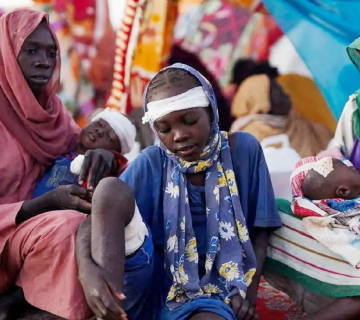Laikipia County is in the Great Rift Valley in Kenya. It is one of the smallest counties, occupying an area of 9,462 square kilometers. The region has different landscapes, and climatic zones ranging from fertile arable land, dry, and arid land to large stretches of range lands. Agriculture is the dominant economic activity. Majority of the residents keep livestock, and grow different food crops such as maize, carrots, peas, potatoes, and wheat. The County is also known for its big, open ranches like the Solio, Laikipa, Ol pejeta, Borana, and Ol jogi. These ranches are a significant source of beef both for local consumption and export.
In addition, the Laikipia region is inhabited by farmers, ranchers and pastoralists who occupy its northern, eastern, and western constituencies. The region is characterized by valuable resources and diverse communities. This has created a complex political narrative with its roots in resource and land grabbing, political wrangling, and human-wildlife conflict.
According to the Maasai (a community), Laikipia is a treeless plain where different kinds of wildlife, including the big five, roam freely on the range lands. The region is a tourist attraction owing to the many wildlife conservancies and ranches therein. History shows that pastoralist communities in the region have coexisted peacefully with wild animals thus eliminating the need for wildlife conservancies. However, the coming of the white settlers changed the notion after they converted the large chunks of land to wildlife conservancies which became an economic value to the country. For instance, Thomson’s falls, Laikipia Ranch, and Ol Pejeta conservancy are some of the tourist attractions in Laikipia. In addition, the county is popular for its abundant wildlife where you find endangered species like the African wild dog and the Bongo. Laikipia is also rich in bio-diversity with over 95 species of mammals, 540 species of birds, over 700 species of plants and almost 1,000 species of invertebrates.
In his book, Wildlife Conservation Strategy for Laikipia County, Max Graham argues that Laikipia regions also contains: half of Kenya’s black Rhino, the country’s second largest population of elephants, Kenya’s third largest and only stable population of lions, the world’s sixth largest population of African wild dogs, a large proportion of the world’s remaining Grevy’s zebras, perhaps as many as two thirds of the world’s remaining Reticulated giraffe, a globally significant population of cheetah, Kenya’s largest population of patas monkeys, and a unique species of hartebeest. These make Laikipia one of the few viable refuges for large terrestrial mammals in East Africa. On the other hand, wildlife in Laikipia is generating significant benefits. For instance, in 2009 the wildlife sector generated an estimated USD 20,500,000 in tourism revenue, directly supporting 6,500 people. The wildlife sector raised a further USD 3,500,000 for social development projects such as education, healthcare, infrastructure development, security and livelihood support, and USD 5,000,000 for wildlife conservation.
Pastoralists in the area lost access to their ancestral land in the early 20th century when British imperialists forcibly removed them (mostly the Maasai) pastoralist community from the Rift Valley and Laikipia. Scholars argue that land-based grievances are the immediate drivers of conflicts in the region; if left unresolved they always turn out to be protracted conflicts. When Kenya attained independence, individual land owners were manifestly expected to claim their property and a redistribution schemes to take place. However, despite the ambitious plan to resettle them, the schemes were engineered to channel land to a few political elites. In Laikipia, the majority of locals were settled on smallholdings in the west, or remained landless. After independence, the white settlers held on to the big chunks of land which have since been converted into private wildlife conservancies. As already indicated, these conservancies are home to some of the rarest animal species in the world (such as the white rhino).
Some of the ranches were purchased by land buying companies and distributed to shareholders who are now small-scale farmers. Their farming activities further aggravated the conflict by blocking wildlife migration routes, and pastoralists access to pasture.
These conservancies nevertheless, have amplified conflict with the local communities. There is glaring inequality in Laikipia between those who reap the benefits of wildlife, and the rest of the residents. Many of Laikipia’s small-scale holders are located on the outskirts of the conservancies where there are wildlife corridors. In addition, there are a growing number of people in Laikipia with limited employment or livelihood options. This has always created the single greatest threat to wildlife species coveted for their meat or to supply parts to the illegal international trade, particularly outside of the existing area that is under conservation compatible land use. This has been one of the major causes of conflict between the private ranchers, pastoralists, and the farmers causing loss of bio-diversity, livestock and crop destruction.
According to privately run conservancies who have concentrated large chunks of land, converting the region to private ranches is of great economic importance than leaving it to pastoralists who put it to ‘waste.’ However, the failure of the private conservancies having a low specification or poorly maintained electrified fences has encouraged elephants, lion and other wild animals to roam freely hence creating the problem of human-wildlife conflict. Also troubling is the use of National Police Reservists by private conservancies. These scouts are private employees, but they are armed by the government through the national police reservist’s initiative. The scouts are not only allowed to use violence to stop poaching, but also act in security matters beyond the conservancy, such as tracking raided cattle. This has the potential to escalate the conflict between private and public interests
The white settlers “legally” acquired theses huge tracts of land through accords such as the 1904 Anglo-Maasai treaty that had the local “offer up” their land in Rift Valley region to the white settlers. Attempts by pastoralists from the region to regain their land after independence proved futile. For instance, in 2004, the Maasai called for the restitution of their land, but the government dismissed their demands. This forced them to move in and invade the ranches with their large herds only to be brutally evicted. The pastoralists retaliated by destroying crops belonging to the small scale farmers surrounding the conservancies paving way for a three way conflict pitting herders, farmers and ranchers. Initially, the conflict was restricted to the northern part of the county, but frequent attacks from the pastoralist have spread the conflict to other parts of the county. Virtually 50% of the Laikipia county land mass is owned by large scale ranchers, who are believed to be less than thirty in terms of population. However, according to the neighbouring pastoral communities in Baringo, Samburu, and Isiolo, who are largely herders, the land owned by the ranchers is idle and should be made accessible to their herds too. This further compounds the already high intra-county tension.
The conflict has been exacerbated by the dry spell between January and April (when rain is expected), which forced the pastoralists to move from one place to another in search of pasture and water. Scholars argue that, these actions though forms of livelihood are perceived as a form of resistance to an unequal distribution of resources primarily stemming from herders. It’s on the record that armed pastoralist groups have, in the past, forcefully driven their livestock herds into ranches or conservancies in Laikipia County. The availability of illegal arms has contributed to the escalation of violence. Marginalization of the entire region is another contributing factor to the increasing conflict. Poverty, poor infrastructure and divergent cultural values fan the flames of discord among local people, thus making the already bad situation worse.
Cattle rustling and banditry, facilitated by the topography of the area, further degenerats the situation. Politics has also come into play in the region with the politicians exploiting poor, marginalized communities. A great deal of the latest round of violence was triggered by politicians armed with information that the 99-year leases held by ranchers in Laikipia were about to expire.
They moved in to incite herders to invade and occupy the affected ranches with the ultimate hope of owning them. This often led to destruction of property, annihilation of wildlife as well as loss of tourism to a region which is a leading destination for thousands of tourists across the globe. According to the 2009, Kenya Bureau of Statistics survey, it is alleged that the massive rate of population growth in Laikipia is a consequence of immigration of smallholder farmers from the south and pastoralists from the north in response to availability of land and associated resources that occurred with the sub-division if large-scale properties after Kenyan independence.
Dealing with such challenges will require a multi-agency approach. For the pastoral communities, investing in lifestyle shift in which the current large herds of indigenous cattle are replaced with smaller higher quality animals with greater returns will be more valuable. Additionally, the cattle should be reared for their commercial value rather than status symbol. The animals should also be scientifically branded with identifier electronic chips to deter rustling and stock theft. The pastoralist communities should be encouraged to embrace formal education that will inform alternative lifestyles other than cattle culture and learn to respect and appreciate other communities’ right to exist. It will also expose them to alternative source of livelihood.
. To the national and county governments, there is need for construction and improvement of existing infrastructure, hospitals, and water boreholes and livestock markets. Credible security systems and forces capable of deterring crimes and violations of privately owned property will also lead to a reduction in the conflict. The conservancy owners could erect strong and deterrent fences to keep the wildlife away from the small scale farmers’ crops and livestock. The county and national governments must establish a channel of dialogue to mitigate any conflict that could bring disharmony among the diverse communities living in Laikipia.




Your point of view caught my eye and was very interesting. Thanks. I have a question for you.
Your article helped me a lot, is there any more related content? Thanks!
Your point of view caught my eye and was very interesting. Thanks. I have a question for you.
I don’t think the title of your article matches the content lol. Just kidding, mainly because I had some doubts after reading the article.
Thanks for sharing. I read many of your blog posts, cool, your blog is very good.
I don’t think the title of your article matches the content lol. Just kidding, mainly because I had some doubts after reading the article.
Can you be more specific about the content of your article? After reading it, I still have some doubts. Hope you can help me.
Can you be more specific about the content of your article? After reading it, I still have some doubts. Hope you can help me. https://accounts.binance.com/ES_la/register-person?ref=T7KCZASX
Your point of view caught my eye and was very interesting. Thanks. I have a question for you.
Thank you for your sharing. I am worried that I lack creative ideas. It is your article that makes me full of hope. Thank you. But, I have a question, can you help me?
Thanks for sharing. I read many of your blog posts, cool, your blog is very good.
Your article helped me a lot, is there any more related content? Thanks!
Can you be more specific about the content of your article? After reading it, I still have some doubts. Hope you can help me.
Your article helped me a lot, is there any more related content? Thanks!
Thank you for your sharing. I am worried that I lack creative ideas. It is your article that makes me full of hope. Thank you. But, I have a question, can you help me?
Thank you for your sharing. I am worried that I lack creative ideas. It is your article that makes me full of hope. Thank you. But, I have a question, can you help me?
Thank you for your sharing. I am worried that I lack creative ideas. It is your article that makes me full of hope. Thank you. But, I have a question, can you help me?
Your point of view caught my eye and was very interesting. Thanks. I have a question for you.
Thanks for sharing. I read many of your blog posts, cool, your blog is very good.